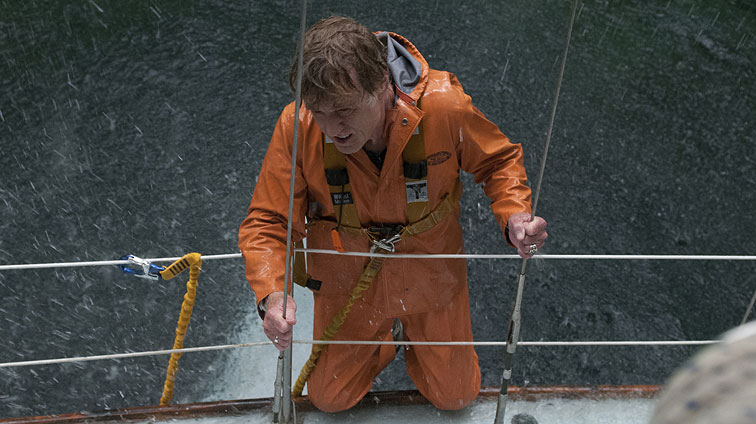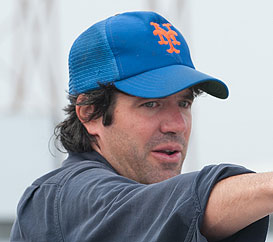
A Sailor's Lament
J.C. Chandor forgoes the use of dialogue to script the harrowing story of a lone man at war with nature and himself in All is Lost.
 Richard Foreman
JC Chandor
Richard Foreman
JC Chandor
I sent it to Redford and within three days of his reading it, I was in his office in Santa Monica. He sort of patted his knees and said, I wanted to make sure you weren't totally crazy and that you had thought this through a little bit.
J.C. Chandor wastes no time getting his story going in All is Lost, his follow up to, and 180-degree departure from, his Oscar-nominated screenplay for Margin Call. After an apologetic farewell letter is recited in voice-over by "Our Man," as Robert Redford's nameless character is called in the screenplay, he is awakened alone and in the middle of the ocean by a noise, to find his small sailboat flooded and damaged from a collision with a lost shipping container. From that moment, a nearly wordless, solo struggle for survival ensues as he battles technology, the elements and his own despair.
Pieces of the story came to Chandor during his commute between New York and Providence, Rhode Island while editing Margin Call. "I love the basic survival story genre," says Chandor. "You can ask interesting questions in potentially interesting ways."
At first he had nothing but that farewell letter in his head, apologetic yet cryptic, devoid of a story into which to weave it. It came to him while gazing out the train window; he wrote it and it sat for four months, no idea of what it was. But through that window he would see thousands of leisure boats docked along the Eastern seaboard, and he thought of the condition which allows for such things.
"When you go around the world there's this bizarre obsession with boats, where essentially 90 percent of them serve no functional purpose in life," he says. "All of these resources and man power put toward them. I had grown up sailing a little bit. You obviously have to have a society and culture with excess, with more than it needs, where it's not worried about feeding itself for this to be going on. The fact that these boats exist at all seemed like an interesting potential Why? How?"
Obviously, the great challenge of this story is the fact that Our Man has nobody to communicate with through the entire movie.
From a writing perspective, in previous versions of this film, people built little bridges, little crutches for communicating traditional narrative elements when essentially it's one character, or a person and a half; someone kind of there. You go back to inanimate objects a volleyball, 127 Hours where you have the video camera to talk to. Or heavy use of voice-over, the Spencer Tracy version of The Old Man and the Sea. That conundrum led to what I thought was in the end potentially fascinating.
It's all about the passage of time obviously, because you are on the slow decline, physically and emotionally, with this character. Hopefully within that there are bursts of hope and life, but how do you tell that story where you are passing time but not taking four hours to do it? Finding that balance, transitioning between days, hours and minutes, was the challenge. Most of it is in the original version of the script, but that became the struggle over four or five months of writing.
Margin Call is a dialogue and ideas driven script whereas All is Lost was a 32-page script detailing physicality, with almost no lines spoken. What did you take from one project into the next?
What I learned from writing Margin Call was using inherent weaknesses in a project as their strength. In Margin Call it was primarily budgetary. At the time I thought I would have under $1 million, but I wanted to do an actor-driven piece, wrapped in this huge global phenomenon. Shooting a film in the world of international financial capital is not a cheap endeavor, so I decided to pick just one floor to be on instead of a string of cities, and I backed myself into what ended up being the strength of that script. By fencing myself in as a writer, and more importantly fencing the characters in, you got to learn exactly why the entire world ended up where it was, because they all fell into those traps.
In All is Lost, I had to push that to its craziest end, but in a survival film, the inherent weakness is that you have this one guy, all alone and isolated. I doubled down on that to see if the strength that came out of it would be an audience's ability to bring its own narrative to the story, if I never got hyper specific about who he was. It's hard to say when I got the confidence to think that I could pull that off, but I know a huge part of it was at Sundance with Margin Call, when I started to think about Redford for the role. I felt like he was an actor who could pull it off.
You talked about these boats as decadent, leisure items. Was that just a side note or is your character's sin one of decadence? Or is it just hubris?
From his point of view, it's not decadence. His is a $26,000 boat, which I chose on purpose. In the greater scheme of America, if someone had a passion for this weird thing, many people could afford one. But when you compare what we do in this country with a lot of the non-industrialized world, then yes. Just like a motorcycle or gardening is decadent, or whatever it is people spend thousands of dollars a year on. It did become a symbol of that, which does bring certain responsibilities and guilt. From a writing perspective, absolutely that was there, for sure.
Did you have an anchor for yourself, so to speak? As long as I do X, my audience will stay with this character?
There were two things. One was that it had to be fun, and I mean that in the darkest sense of the word. It had to be a swashbuckling sea adventure for a good part of the movie. I've never been a huge fan of, or fully understood act structure and people always say, even if you don't understand it, it's there but this film was structured very formally as three acts: man vs. man, man vs. nature, and then it's man vs. self for the third act. I clung to the fact that the first two acts had to be swashbuckling adventure and have some big action sequences. To go on this difficult, monotone journey, I felt like I owed it to the audience to give them some fun action beats, and have sequences that made you feel like you'd been put through the life and death challenge. There was a price point to the film, and I want to do some fairly significant things safely, but I did feel like I, as an audience member, needed the adventure element. The biggest concern, which I had to constantly remember, was the emotional journey he goes on moment to moment.
The genius of what Redford was able to bring, which is what so few people are, is fairly specific, nonverbal emotional transition on his face. He moves from fear to perseverance to despair throughout the film, and from question to answer. It's the art of what he does, which can be undervalued, but it's intense to watch because he can literally turn it on and off. I had assumed at writing it was going to be necessary so I baked it into the script, but capturing it was a fear of mine until we started shooting. We needed the emotional connection and understanding of where this guy was emotionally at every point. I can't say that I was convinced that I was going to find the person able to do that, but that's where the search began. I sent it to Redford and within three days of his reading it, I was in his office in Santa Monica. He sort of patted his knees and said, "I wanted to make sure you weren't totally crazy and that you had thought this through a little bit. It seems like you have, so let's go do this." It then took a year to put it together, but we did.
© 2013 Writers Guild of America West
